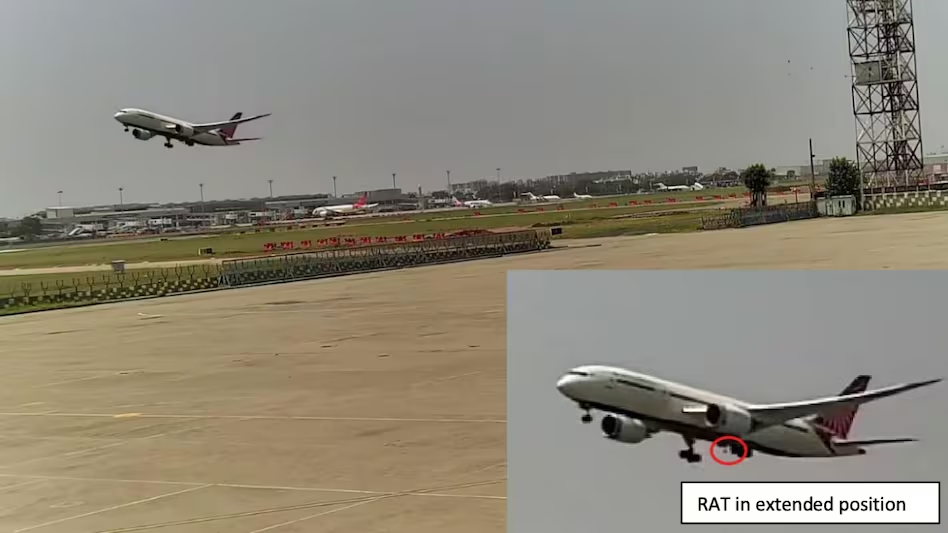On June 12, 2025, an Air India Boeing 787-8 crashed shortly after takeoff from Ahmedabad, India, in a tragedy that has gripped the nation and raised urgent questions about aviation safety. The preliminary report from India’s Aircraft Accident Investigation Bureau (AAIB), released on July 12, 2025, revealed a chilling detail: both engines of the aircraft shut down within seconds of each other due to the fuel cutoff switches moving from “RUN” to “CUTOFF” almost simultaneously. This unprecedented event has sparked intense speculation, with theories ranging from mechanical failure to human error and even sabotage. As investigators dig deeper, this article explores the findings, possible causes, and implications of this catastrophic incident, aiming to provide clarity amid the chaos.

What the Preliminary Report Reveals
According to the AAIB’s 15-page preliminary report, the sequence of events unfolded rapidly:
- 08:08:42 IST: Engine 1’s fuel cutoff switch transitioned from RUN to CUTOFF.
- 08:08:43 IST: Engine 2’s fuel cutoff switch followed suit, just one second later.
- Cockpit Voice Recorder (CVR): One pilot was heard asking, “Why did you cut off?” to which the other responded, “I didn’t.” This exchange suggests confusion in the cockpit and no clear intent to shut down the engines.
The simultaneous fuel cutoff led to a complete loss of power during the critical takeoff phase, causing the aircraft to lose altitude and crash. The report also noted the deployment of the Ram Air Turbine (RAT), an emergency power system that activates during a total power failure, corroborating the dual-engine shutdown.
Possible Causes Under Investigation
The AAIB has not yet concluded the cause of the fuel cutoff, but several theories are being explored based on the preliminary findings and expert analyses:
- Human Error:
- Initial speculation pointed to pilot error, with some suggesting the pilots may have mistaken the fuel cutoff switches for another control, such as the landing gear or flaps. However, the CVR’s indication of surprise from both pilots challenges this theory.
- The rapid sequence of events—within one second—suggests that if human error was involved, it was an extraordinarily rare and precise mistake.
- Mechanical or System Malfunction:
- A potential fault in the Boeing 787-8’s fuel control system is under scrutiny. Could a glitch or design flaw have triggered the fuel cutoff switches simultaneously?
- Maintenance records of the aircraft are being examined to determine if prior issues with the fuel system or engine controls went unreported or unresolved.
- Sabotage or External Interference:
- Posts on X and comments from aviation enthusiasts have raised the possibility of foul play, with some suggesting sabotage as a cause. India’s Civil Aviation Minister described the incident as a “rare case,” noting that simultaneous engine shutdowns are unprecedented.
- While no evidence of sabotage has been confirmed, investigators are reportedly considering this angle, given the unusual nature of the event.
- Fuel Contamination or Supply Issue:
- Another theory posits that contaminated fuel or a disruption in the fuel supply could have caused the engines to shut down. The AAIB is analyzing fuel samples from the aircraft and the airport’s supply chain.

The Human Toll and Public Reaction
The crash claimed numerous lives, though exact figures remain unconfirmed in the preliminary report. The tragedy has sparked widespread grief and outrage across India, with families demanding answers and accountability. Social media platforms, particularly X, have been abuzz with discussions, ranging from technical analyses to conspiracy theories. One X user, an aviation engineer, highlighted the improbability of both engines failing simultaneously, calling it “a one-in-a-million event” unless external factors were involved. Another user speculated about Boeing’s manufacturing quality, referencing past issues with the company’s aircraft.
Air India’s Response and Industry Implications
Air India has pledged full cooperation with the AAIB and international investigators, including Boeing and the U.S. National Transportation Safety Board (NTSB). The airline has grounded its Boeing 787-8 fleet pending further inspections and issued a statement expressing condolences to the victims’ families. The incident has reignited debates about aviation safety in India, with calls for stricter oversight of maintenance practices and pilot training.
Globally, the crash has raised concerns about the Boeing 787-8’s reliability. Aviation experts are questioning whether this incident could point to systemic issues in the aircraft’s design or production, especially given Boeing’s recent history of scrutiny over safety standards.

What’s Next for the Investigation?
The AAIB’s preliminary report is just the beginning. A comprehensive investigation, expected to take months, will involve:
- Detailed analysis of the flight data recorder (FDR) to map the aircraft’s systems behavior.
- Interviews with ground crew, maintenance staff, and air traffic controllers.
- Collaboration with international bodies to rule out or confirm sabotage.
- Simulations to recreate the cockpit environment and test human error scenarios.
Until the final report is released, speculation will likely continue to swirl. The aviation community and the public are watching closely, hoping for answers that can prevent such a tragedy from happening again.
Conclusion
The Air India crash of June 12, 2025, is a stark reminder of the fragility of air travel and the complexities of modern aircraft systems. The simultaneous shutdown of both engines, as revealed by the AAIB’s preliminary report, raises more questions than answers. Was it a catastrophic human error, a mechanical failure, or something more sinister? As investigators work to uncover the truth, the nation mourns, and the world waits for clarity. Stay tuned for updates as this story develops.
Last Updated on: Saturday, July 12, 2025 7:33 pm by K Nikhil | Published by: K Nikhil on Saturday, July 12, 2025 7:32 pm | News Categories: India